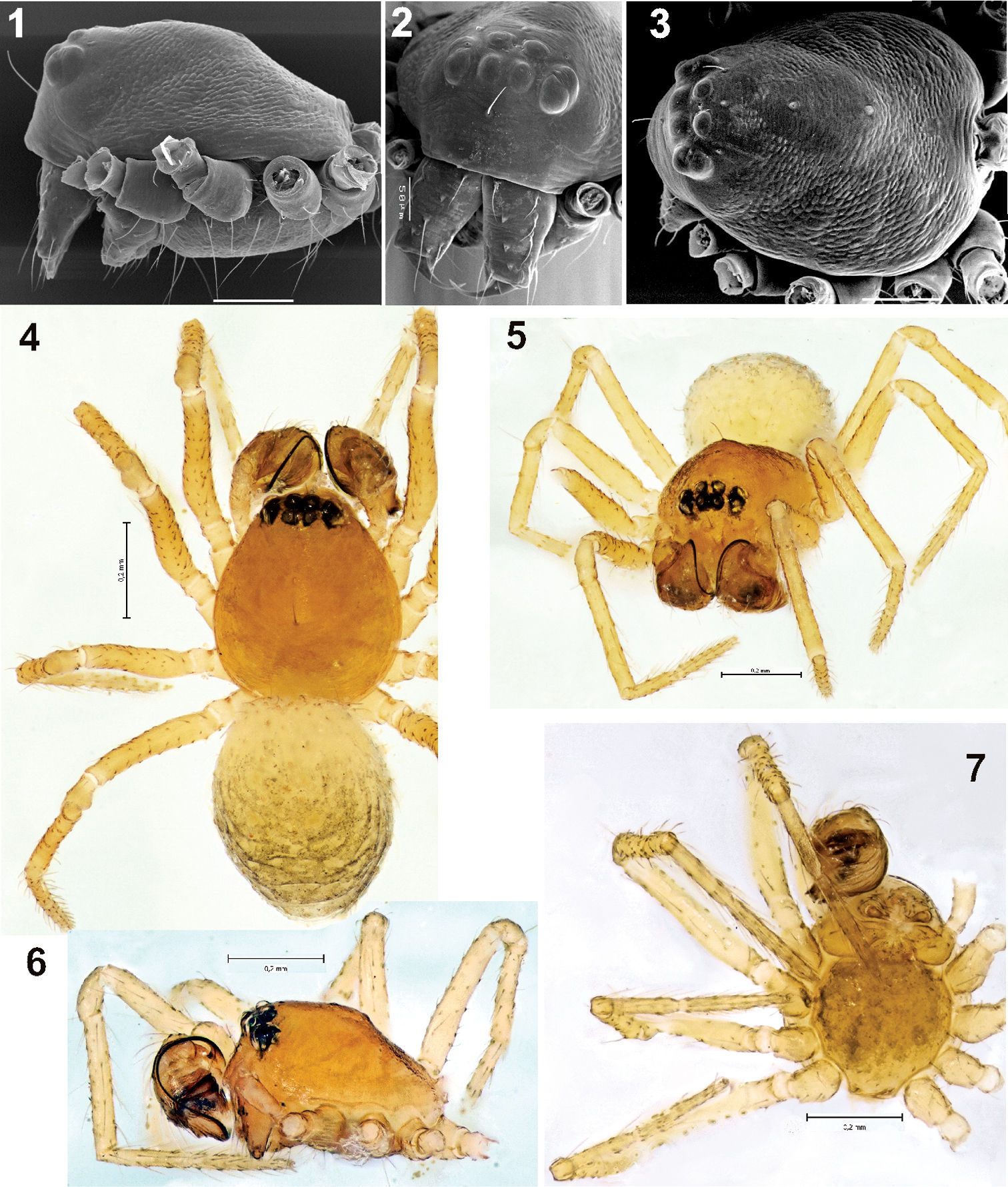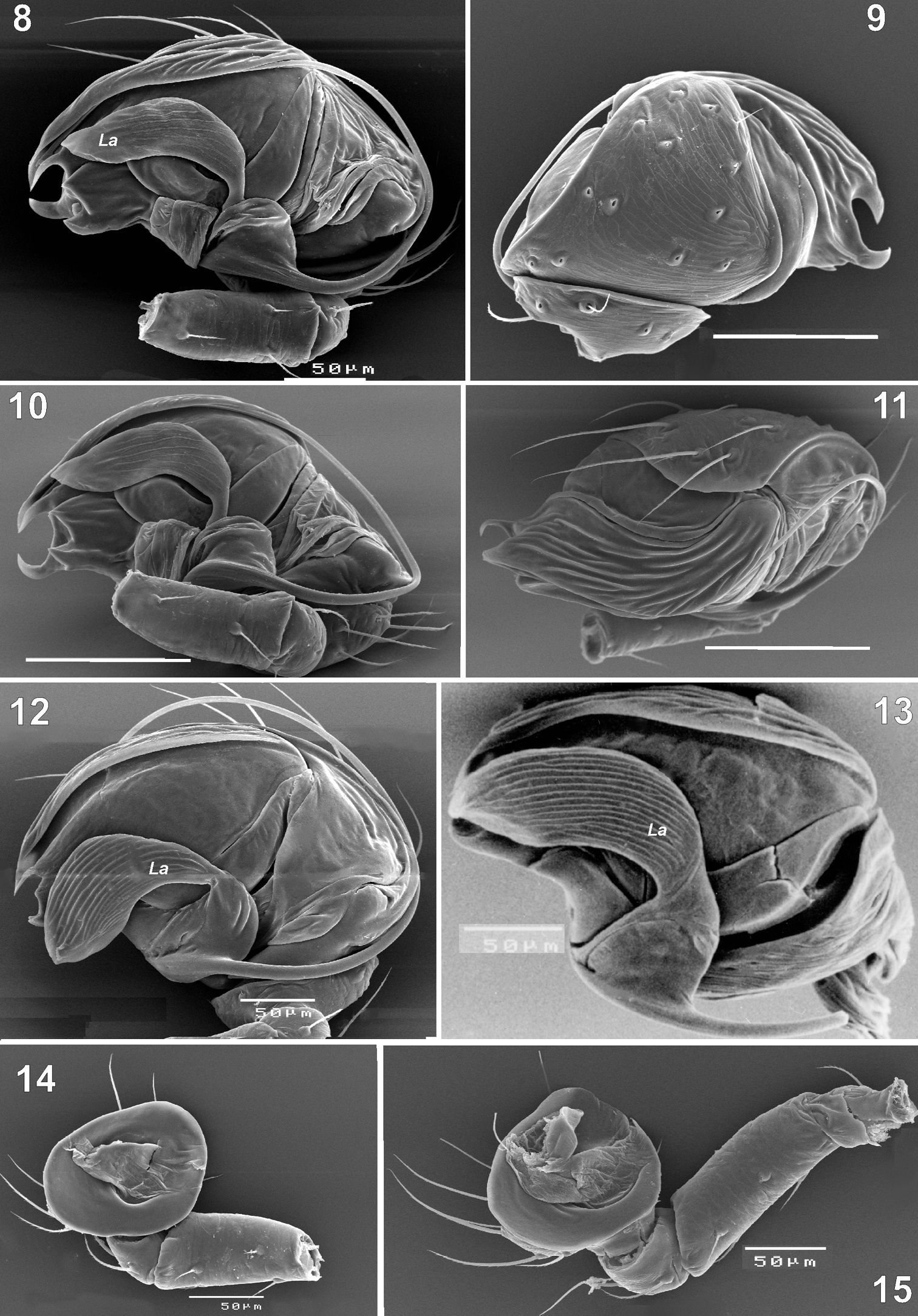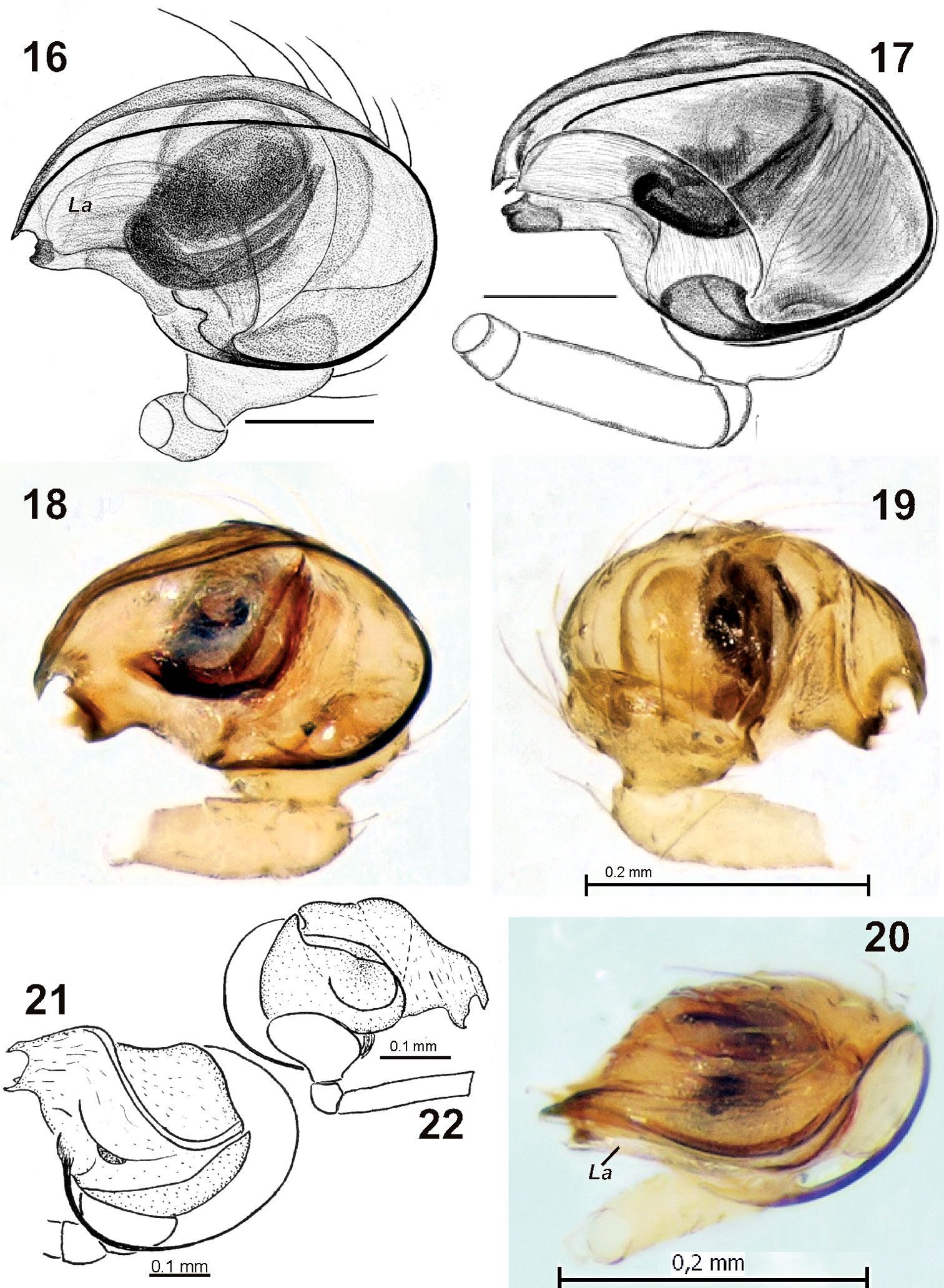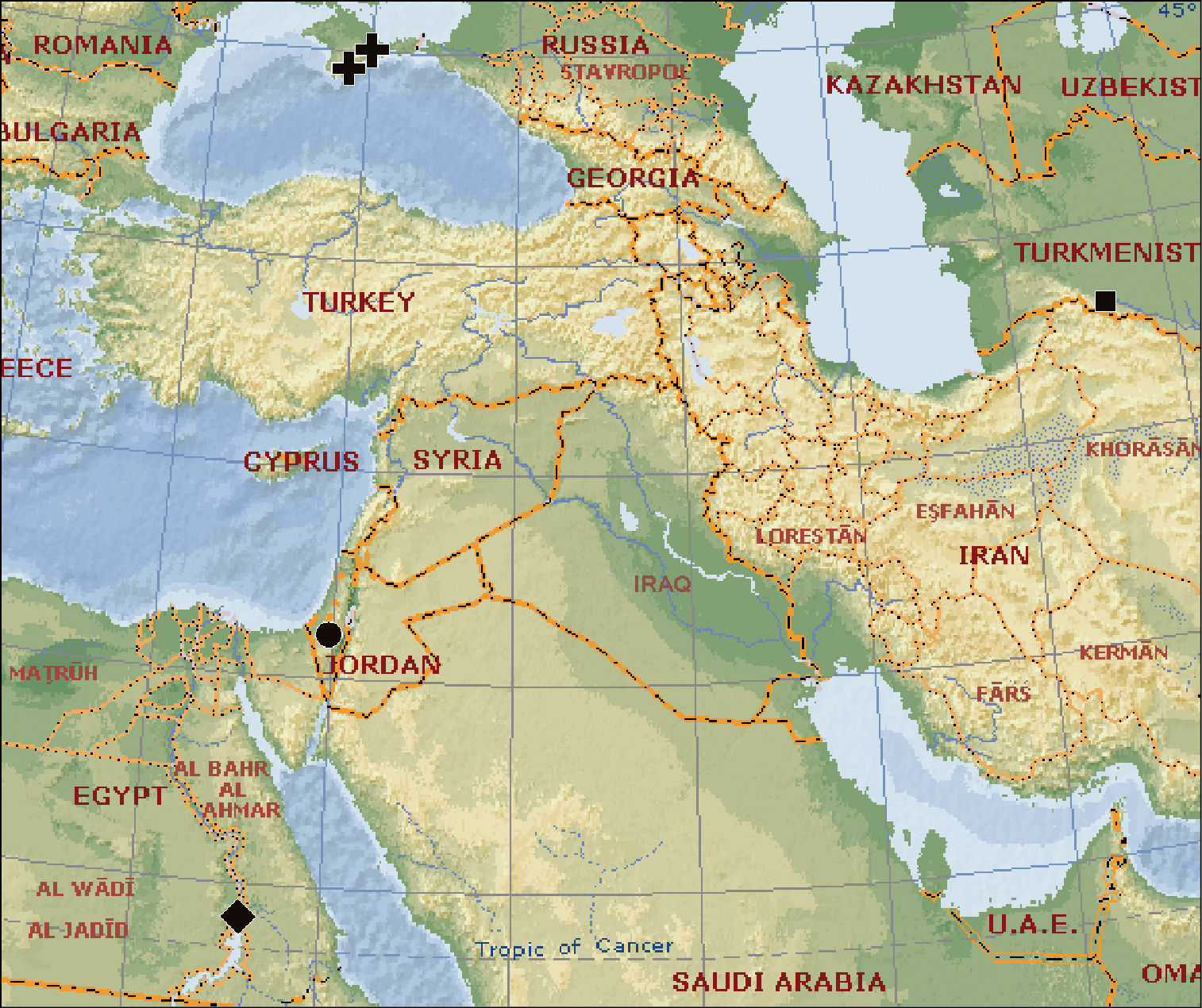






(C) 2010 Yuri M. Marusik. This is an open access article distributed under the terms of the Creative Commons Attribution License, which permits unrestricted use, distribution, and reproduction in any medium, provided the original author and source are credited.
For reference, use of the paginated PDF or printed version of this article is recommended.
Three species of Synaphris occurring in the East Mediterranean – Synaphris orientalis Marusik & Lehtinen, 2003, Synaphris lehtineni Marusik, Gnelitsa & Kovblyuk, 2005 and Synaphris letourneuxi (Simon, 1884) – are surveyed; and a new species – Synaphris wunderlichi sp. n. – is described from southern Israel on the basis of males. The new species differs from other East- Mediterranean congeners by its smaller size, a smaller lamella with fewer ridges, and a thick palpal femur. Comparative figures are provided for all species from the East Mediterranean.
Spiders, East Mediterranean, distribution
Synaphridae Wunderlich, 1986 is a small family with
three genera and 12 species known from the Mediterranean region
(including adjacent territories: the Canary Islands and western
Turkmenistan) and Madagascar (cf.
While studying material collected in Israel by pitfall traps we identified over two dozen specimens belonging to Synaphris and initially thought they might be Synaphris letourneuxi, the species described from Egypt and known only from the male holotype. A detailed examination of our specimens, as well as their comparison with the literature and all the available material, has revealed them to belong to an unknown species. This study surveys all the species currently known from the East- Mediterranean region and describes a new species.
Material and methodsDigital photographs of general appearance and copulatory
organs were taken using an Olympus SZX16 stereomicroscope with an
Olympus E-520 camera and prepared using the CombineZP software. These
photographs were taken in alcohol, in dishes with paraffin at the
bottom. Different-sized hollows were made at the bottom to maintain the
specimens in the desired position. Scanning electron photos were taken
using the SEM JEOL JSM-5200 scanning microscope at the Zoological
Museum, University of Turku. All measurements are in mm. Type material
will be deposited at the Department of Zoology, Tel-Aviv University
(TAU), the National Spider Collection at the Hebrew University,
Jerusalem (HUJ), Göteborgs Naturhistoriska Museum (GNM) and the
Zoological Museum, University of Moscow (ZMMU). The terminology follows
To date, three species of Synaphris have been known from the East-Mediterranean region (east of 20°E) (cf.
Figs 12, 15–16
Comments.This species was described on the basis of 30 specimens collected from a single Crimean locality (
Figs 21–22
Comments. This is the type species of the genus. The species remains known from the male holotype only, collected in Aswan (=Assuan, Egypt). Although it has been redescribed several times, details of its male palp remain unknown. Neither lamella, nor the embolus basis, the course of the seminal duct or position of the cymbial furrow have been depicted or verbally described.
Figs 13, 17
Comments. Like the type species, Synaphris orientalis
remains known from the male holotype only, collected in western
Turkmenistan. Despite this, the species was studied by means of
scanning electron microscope and properly described by
urn:lsid:zoobank.org:act:90027054-25C3-43EB-9C22-462F3640BCD0
Figs 1–11, 14, 18–20Material: Holotype ♂ (TAU) and paratypes 29♂♂ (HUJ, TAU, GTM & ZMMU) ISRAEL: Adulam 8 km SSW Beit-Shemesh, 31°39'N, 34°57'E, 350–400 m, oak maquis (Quercus calliprinos), pitfall traps, 15.04.2003 (U. Columbus & T. Levanony).
Note. Although the species was numerous in pitfall traps, the second author (SZ) was unable to find any specimen by hand-picking or sifting the litter.
Etymology. The species name is a patronym in honour of our friend and colleague, the noted arachnologist Jörg Wunderlich (Germany), who erected the subfamily Synaphrinae.
Diagnosis. The new species can be separated from other East-Mediterranean species, Synaphris orientalis, Synaphris lehtineni and Synaphris letourneuxi, by its smaller size (carapace < 0.5, in all other species longer than 0.5). In addition to size, the new species can be recognized by the relatively smaller lamella (cf. Figs 8, 12–13), with less developed ridges. Number of lamellar ridges in the new species (about 6) is approximately half that of its East-Mediterranean congeners. In addition, Synaphris wunderlichi sp. n. has a relatively shorter and thicker palpal femur (cf. Figs 14–15, 17–19, 22). The new species is most similar in size to Synaphris dalmatensis Wunderlich, 1980, but the Balkan species has relatively longer legs, and unlike other Synaphris species, it has tarsus I shorter than metatarsus I (0.24 and 0.21 respectively). The shape of the lamella in Synaphris dalmatensis is unknown.
Description. Male. Total length 0.91–0.96. Carapace: 0.46 long, 0.41 wide, uniformly coloured light brown with three dorsal median setae as in other species. Abdomen oval, lighter than carapace, without pattern.
Leg joint measurements:
| Femur | Patella & Tibia | Metatarsus | Tarsus | Total | |
|---|---|---|---|---|---|
| I | 0.357 | 0.400 | 0.243 | 0.257 | 1.257 |
| II | 0.357 | 0.386 | 0.200 | 0.243 | 1.186 |
| III | 0.314 | 0.314 | 0.200 | 0.243 | 1.071 |
| IV | 0.386 | 0.371 | 0.214 | 0.257 | 1.228 |
Prosoma and habitus of Synaphris wunderlichi sp. n. 1–3 prosoma with removed legs and palps, lateral, frontal and dorsal 4–5 habitus, dorsal and frontal 6–7 prosoma, lateral and ventral. Scale = 0.1 mm if not otherwise stated.
Scanning electron microphotographs of the male palp of Synaphris wunderlichi sp. n. (8–11, 14), Synaphris lehtineni (12, 15) and Synaphris orientalis (13). 8, 12–13 prolateral 9 retrolateral 10 caudal 11 anterior 14–15 palp with removed bulbus showing femur-tibia, anterior. Scale = 0.1 mm if not otherwise stated.
Male palp of Synaphris lehtineni (16), Synaphris orientalis (17), Synaphris wunderlichi sp. n. (18–20) and Synaphris letourneuxi (21–22). 16–18 prolateral 19, 22 retrolateral 20 anterior 21 retrolateral-anterior. Scale = 0.1 mm if not otherwise stated. 16–17 after
The palp as in Figs 8–11, 14, 18–20. Femur short and thick; patella small; tibia wide, round and flat (Fig. 14); lamella lanceolate with six longitudinal ridges, lamella invisible in compound microscope in prolateral view, but can be found in terminal view (Fig. 20); seminal duct in the base of embolus is straight (Fig. 18).
Distribution. Type locality only.
Comments. When we first examined these specimens from Israel, we thought that they might be conspecific with the generotype, Synaphris letourneuxi, described and known from neighbouring Egypt. The type locality of Synaphris letourneuxi, near Aswan (=Assuan), is quite distant from southern Israel. The holotype of Synaphris letourneuxi is 1.28 long, with carapace 0.53 long, distinctly larger than the new species. In addition to differences in the terminal part of the bulbus, Synaphris letourneuxi has a thinner and relatively longer palpal femur (cf. Fig. 22). Unfortunately, the lamella in this species remains unknown, as in all other species described prior to its first observation in 2003.
A map showing type localities and distribution of Synaphris letourneuxi (♦), Synaphris lehtineni (+), Synaphris wunderlichi sp. n. (•) and Synaphris orientalis (■).
All Synaphris species are very similar in general appearance and differ only in details of the terminal part of the bulbus and shape of the lamella; the latter is yet known only in Synaphris wunderlichi sp. n. Females are known in a few species, making it impossible to provide an identification key for the entire genus, or even for the species occurring in the East Mediterranean. Nevertheless, the species living eastward of 20°E can be easily differentiated by their sizes (Table 1)
Comparison of size of East Mediterranean Synaphris species.
| Total | Carapace length | Leg I | Femur I | |
|---|---|---|---|---|
| Synaphris wunderlichi sp. n. | 0.91–0.96 | 0.46 | 1.26 | 0.36 |
| Synaphris orientalis | 1.06 | 0.54 | 1.4 | 0.43 |
| Synaphris letourneuxi | 1.28 | 0.53 | 1.56 | 0.47 |
| Synaphris lehtineni | 0.96–1.09 | 0.52–0.54 | 1.29 | 0.38 |
Interestingly, all the Synaphris species described from the Palaearctic Region, except for Synaphris lehtineni known from two localities (see Map 1)
are known from a single locality, whereas both species from Madagascar
were found in several localities, even on the opposite sides of the
island. The same holds true for Cepheia longiseta (Simon, 1881), which is known from at least seven separate localities, from south-west Portugal to Switzerland (
Given that all the Palaearctic species have a very local distribution, it is likely that any new findings may represent a new species. We expect a true species diversity of Synaphris to be at least twofold its presently known one.
We thank Seppo Koponen who arranged the visit of YM to Turku and enabled his use of the local facilities (SEM and digital camera attached to microscope); and Naomi Paz for the linguistic help. This work was supported in part by the RFFI grant # 09-04-01365 and the Ministry of Absorption, Israel.



